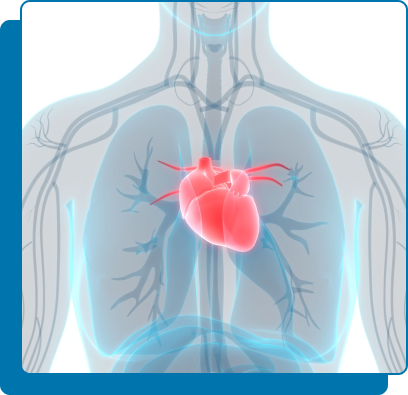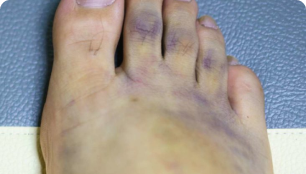
Aorta is the largest artery of the body. The average diameter in the chest (thoracic aorta) is up to 28 mm, and around 20 mm in the abdomen (abdominal aorta). The normal diameter of the abdominal aorta can range between 14 – 30 mm.
When the abdominal aorta develops a weakness and bulges or expands in size more than 1.5 times its average normal diameter, it is called an aortic aneurysm. The pressure of the blood with every heart beat can cause further weakening of the aorta, causing it to bulge (much like a balloon).
The term aortic aneurysm is used interchangeably with the term aortoiliac aneurysm, because the iliac arteries are quite often also aneurysmal in the presence of an abdominal aortic aneurysm and their treatment strategy is typically similar.
Isolated iliac artery aneurysms are rare. A common iliac artery is considered normal if its diameter is less than 17mm (males) or 15mm (females), ectatic if between 17-25mm, and aneurysmal if above 25mm.
if they affect the abdominal aorta proximally to the origins of the renal arteries; these are one of the types of thoracoabdominal aneurysms. An aneurysm that involves the renal arteries may be classified as juxtarenal or pararenal.
Infrarenal aneurysms
if they affect only the segment of the aorta distally to the origins of the renal arteries; these are the most common type (about 95%)
If the aneurysm is not treated, the aortic wall continues to weaken and the aneurysm to enlarge. Eventually, the aneurysm becomes large enough and its wall too weak and bursts (ruptures). A ruptured aneurysm can cause very severe internal bleeding leading to shock and death in most cases.


Feeling of pulsations in your abdomen, similar to a heartbeat

Pain in the abdomen or in the lower back. If there is severe pain of sudden onset, it is likely that the aneurysm is about to rupture. A less common type of aneurysm, the inflammatory aortic aneurysm, which is characterised by retroperitoneal fibrosis and obstruction of the ureters, is more likely to cause pain

In rare cases, your feet and toes may develop areas with bluish discolouration and pain, because of embolization (ie shedding of debris downstream) from the the aneurysm. Another term for peripheral atheroembolism is “blue toe syndrome
Aortic aneurysms are commoner in men. You are at increased risk of developing an aortic aneurysms if you are:
- A man over 60 years of age. The risk increases with the age. Among men of 65-80, the percentage of those with an AAA is 2-5%. Among women of the same age, the percenage is up to 1%
- A smoker
- A man whose father or brother has/had got an aneurysm
- A man with either coronary or peripheral arterial disease

As your nephrologist (or renal physician or kidney disease specialist) would have already explained to you, you have a condition called end-stage chronic renal failure, which means that your kidneys have suffered irreversible damage so that they cannot filter your blood efficiently from accumulating waste products. Your kidney function will be taken over by the dialysis machine to which you will be connected 2-3 times a week.
This connection is performed via two fine and flexible catheters, which will be introduced in your vein through the skin each time. The first catheter (“artery”) will direct your blood to the machine, where it will be filtered. The blood, cleaner now, will be returned to your circulation via the second catheter (“vein”) and through the other puncture site.
The vascular access procedures, namely the construction of a fistula or a graft implantation, aim at creating the possibility for the Dialysis Unit staff to have easy access to a vein just under the skin, which has high flow rate.
The vascular surgeon will try to identify a suitable superficial vein of an upper limb (forearm or arm) and create high blood flow in it by connecting it with sutures to a nearby artery. This direct arterio-venous communication is called a fistula.
However, if your veins are too thin or scarred by previous punctures for blood taking, IV drug administration etc, the vascular surgeon is very likely to have to implant a graft (plastic tube) under you skin with its one end connected to an artery and the other end to a vein of yours so that a high blood flow is maintained in it.
If your upper limbs are thought to be unsuitable for such a procedure, it can be performed in a thigh or very rarely in other areas of your body.
Apart from a suitable vein, you need to have a suitable artery for sewing without much calcification on its wall. At the same time, if the arterial circulation to your limb is narrowed, there is risk for reduction of the blood supply to the limb (arterial steal syndrome) which can put the fingers or hand at risk for amputation.
The vascular surgeon also will be reluctant to implant a graft if there is an active infection anywhere in your body, because of the risk of graft infection. If graft infection occurs, the graft will have to be removed.
Before selecting the operation site, the vascular surgeon will examine your limbs and will organize a duplex scan for mapping of your arm veins. You will also be instructed whether you need to discontinue any drug which could increase the risk for bleeding.
You will be admitted in the early hours on the day of the procedure. If your procedure is set for the afternoon, you will be requested to have a small meal fairly early in the morning.
It is recommended to bring all prior health-related documents so that your doctor can easily access it. You will need to sign a consent document attesting to your understanding of the need for the procedure, its risks, and your agreement to have the surgery.
The operation is usually performed under local anesthetic, however, the vascular surgeon may ask the anesthetist to give you light sedation or rarely general anesthesia.
The vascular surgeon will try to construct the fistula with an incision using the forearm of your non-dominant upper limb. For example, if you are right-handed, your physician will place the fistula in your left upper limb, if possible. To perform the operation, your surgeon joins a suitable vein under the skin to an artery nearby. As a result, the blood flows down the arteries into the hand, as usual, and also some of this faster-moving blood flows into the veins that lead back to your heart. The vein (now called the fistula) will gradually start to “mature” (i.e., increase in size and its wall will become stronger) so that in 5-6 weeks, it should be suitable for inserting the dialysis needles in it. If it does not mature in a reasonable period, e.g., three months, you may need a new operation.
If it is assessed preoperatively that you need an AV graft: Your surgeon will attach one end of the graft to one of your veins and the other end to an artery. The graft material will be placed straight or will form a loop under the skin, either in your lower arm or upper arm. Grafts can usually be punctured within 2 weeks.
It is generally preferable to have a fistula than a graft because it resists infections and has better long-term patency. However, if your veins are not suitable, a graft is an excellent alternative.
- Some pain or swelling are frequent and you should not worry as long as they improve. Persistent pain may indicate infection or bleeding for which consultation may be required
- Keep the wound dry for 4-5 days. If you have non-absorbable stitches, these will need to be removed usually in 7-10 days
- Avoid lifting more than about 8 kg or other activities that stress or compress the access area, such as digging
- As soon as the post-operative discomfort subsides, you should start doing exercises to help your fistula develop and become stronger. In general, we advise using the same hand to squeeze a soft object.
- You may initially feel some coolness or numbness in the hand with the fistula. These sensations usually go away in a few weeks as your circulation improves. Tell your doctor right immediately if these symptoms are severe or persist since the fistula may be causing “ischaemic steal,” or an excessive amount of blood flowing out from your hand.
- Grafts mature faster than fistulae, however they have some disadvantages: they are more likely to get infected and tend to last less than fistulae. However, if you take good care of your graft, you can help it endure for many years.
- Until the AVF access is ready, a catheter in a central vein (usually in your neck) may have to be used for dialysis.
Potential complications with dialysis access procedures include:
- Bleeding
- Infection
- Stenosis (narrowing) or thrombosis (occlusion) of the access
- Limb swelling
- “Ischaemic Steal Syndrome” discussed above
- Aneurysm (localised vein/ artery swelling) formation.
Protecting your vascular access is crucial for you!
- Check several times each day that it is functioning. You must be able to feel a vibration called a “thrill”. Your physician or Dialysis Unit staff will be able to show you how to do this
- Monitor for swelling, redness or bleeding after dialysis.
- Keep the access site clean.
- Do not carry heavy things with the arm which has the access.
- Avoid sleeping the night near the access.
- Do not wear any tight sleeved clothes or jewellery (which can press on the fistula)
Do not let anyone measure your blood pressure on this arm, draw blood or give injections into your fistula or graft.
